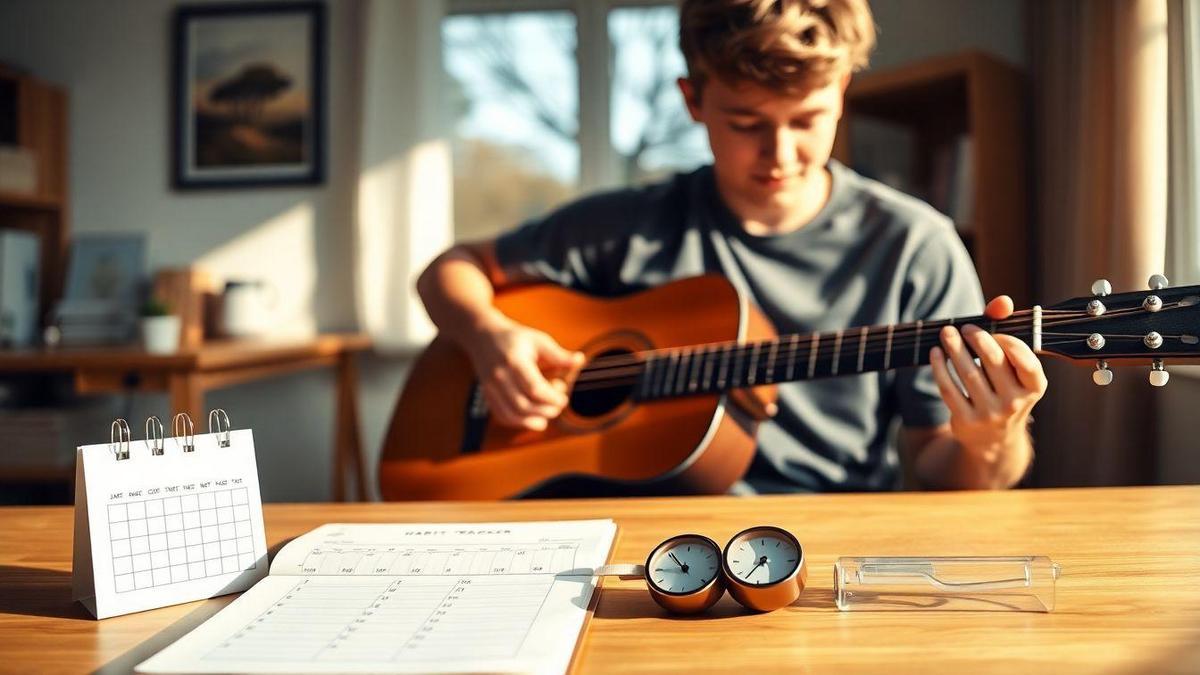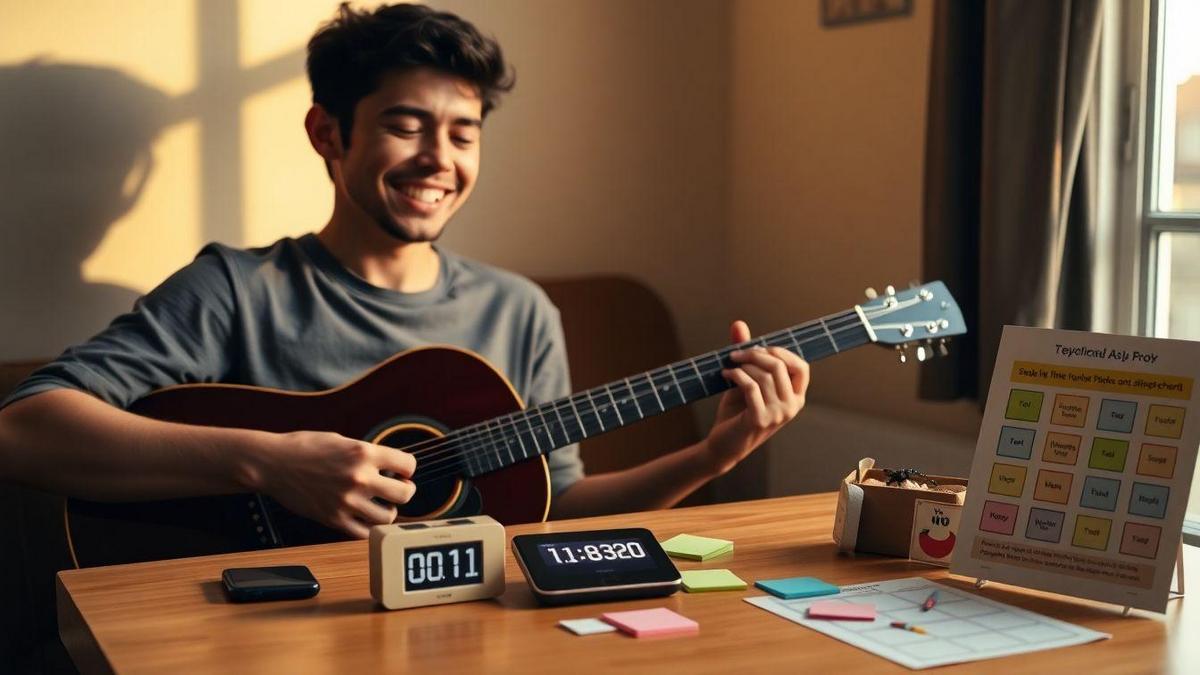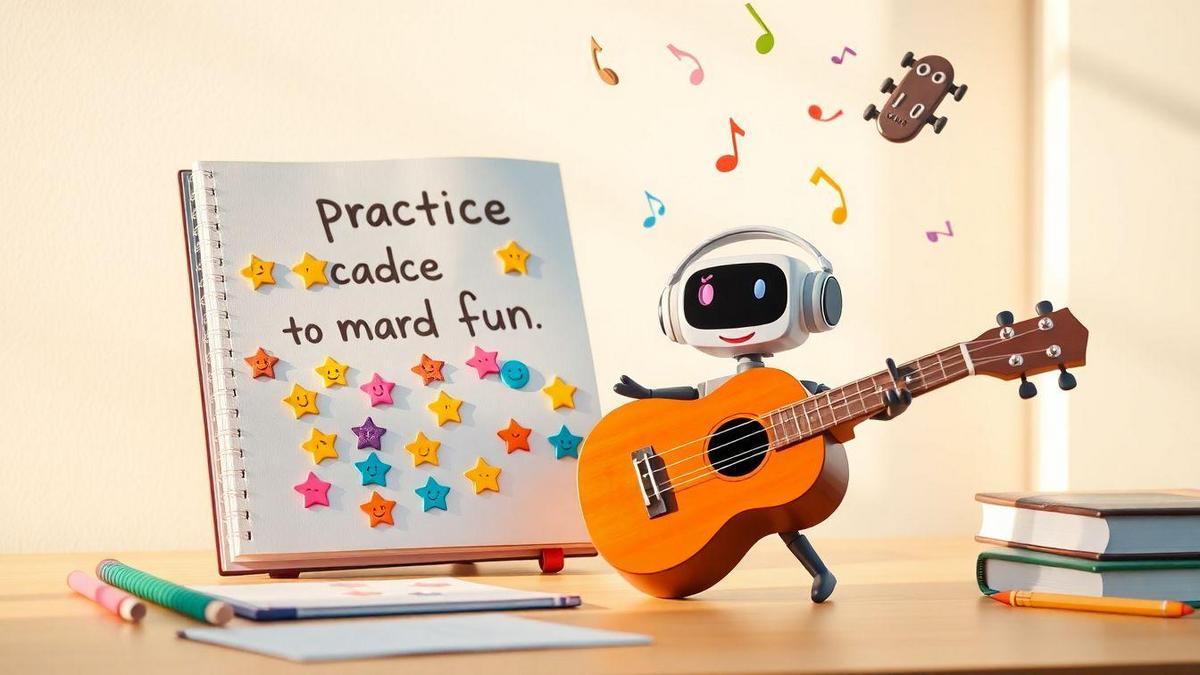Making practice fun instead of a chore
Making practice fun instead of a chore is my north star. I use gamified practice to keep sessions playful and focused. Below I share small game rules, the tools I use to track points and badges, and my two-minute start rule to cut resistance. I walk through tiny habit steps, simple cues and triggers, micro-practice blocks, and a sample ten-minute session plan that fits a busy day. I add playful drills, role play, quick warm-ups, rewards for small wins, accountability systems, progress snapshots, and a rest-and-rotate plan so practice stays fresh and never burns me out.
Key takeaway
- I turn drills into quick games I enjoy.
- I pick tiny goals I can beat.
- I give myself fun rewards after practice.
- I practice with friends to stay excited.
- I change tasks so I don’t get bored.

How I use gamified practice to keep sessions fun and focused
I turned practice into a game to stop dreading it. I wanted short wins, clear goals, and visible progress. That shift made Making practice fun instead of a chore real for me. I play small rounds, keep score, and give myself tiny rewards. It keeps my focus sharp and my mood light.
Small game rules to boost engagement
- Round length: 15-minute timer—work hard, then rest.
- Point system: 10 points for a completed round, 5 for partial success.
- Streak bonus: 3 days in a row = 20 points.
- Challenge cards: small tasks on index cards; win a card = bonus.
- Light penalty: miss a round = −5 points (keeps me honest without guilt).
These rules act like a board game—clear choices that keep me curious and engaged. For a compact daily plan that fits into busy schedules see why short, regular practice works.
Tools I use to track points and badges for consistent play
I mix apps and paper—tools that are fast and visual.
| Tool | What I track | How I use it | Why I like it |
|---|---|---|---|
| Habitica (app) | Points, badges, streaks | Log rounds; get XP and badges | Feels like an RPG; fun visuals |
| Google Sheet | Total points, weekly tally | Add points after each session; formulas sum score | Quick math; clear history |
| Sticker chart (paper) | Daily streaks | Place a sticker for each completed day | Tangible; satisfying |
| Pomodoro timer | Round time and breaks | Run 15-min rounds with 5-min breaks | Keeps on task; simple |
I check my sheet weekly and move small wins into a reward jar. Seeing numbers builds momentum.
Quick game rules for daily drills
- Three-move rule: nail three small items per session.
- Beat the clock: finish a drill faster than yesterday.
- One surprise: add one random mini-task.
- Mini-reward: 50 points = small treat.
These live on my desk and take seconds to follow—making short practice feel like a friendly contest.

How I build practice habit formation that sticks
Simple cues and triggers to make practice automatic
I hook practice to a single, clear cue so starting requires no decision. My go-to cues: morning coffee, the end of lunch, or the couch after dinner. I use physical triggers—leave my practice book on the chair I use after dinner—so seeing the object nudges me to start. The simplest triggers work best: a time, a place, or an object. For more on building tiny, repeatable routines see simple practice routine ideas.
| Cue (When) | Trigger (What I see) | Action (What I do) |
|---|---|---|
| After breakfast | Guitar on the table | Play 1 warm-up |
| After work | Headphones on desk | Do 10 minutes of scales |
| Before bed | Practice journal open | Write one learning note |
These pairs make practice almost automatic—rarely a debate to begin.
Tiny habit steps to avoid overwhelm
I break everything into tiny, doable steps. Small wins build momentum. My rules:
- Start very small.
- Make it specific.
- Stop while curious to repeat tomorrow.
| Skill | Tiny Step | Time |
|---|---|---|
| Sight-reading | Read one bar | 2 minutes |
| Finger dexterity | One slow exercise | 3 minutes |
| Song learning | Repeat one phrase | 5 minutes |
A check mark or quick praise after each tiny win is a small reward that keeps me coming back. These tiny-goal ideas align with the core ideas of self‑determination theory. If sight-reading feels intimidating, a short primer on how to read chords and sheet music can speed progress: basic reading tips.
My 2-minute start rule
Always begin with 2 minutes. It’s so small I can’t refuse. Set a timer for 2 minutes and begin—often I stop, sometimes I keep going. This rule defeats perfectionism and trains the brain to expect a win. If starting is the hard part, strategies for overcoming the fear of starting are a great complement.
- If I dread practice: Two minutes only.
- If tired: two minutes removes pressure.
- If energized: two minutes becomes twenty.

How I make practice routines made fun with short sessions
Making practice fun instead of a chore starts with small wins. I break practice into short bursts so it feels like a quick game, not a slog. That mindset changed how I show up—lighter, curious, and consistent.
Why I choose micro-practice blocks
I choose micro-practice because it cuts friction. Ten minutes is doable and lets me focus fully. Repetition in small chunks beats marathon sessions for memory and feedback. Every tiny success is a real motivator. The evidence behind spaced and short practice supports this approach: evidence behind spaced and short practice. If you want evidence that short daily practice moves the needle, see the case for short, steady practice.
Benefits:
- Consistency: a little every day.
- Focus: attention stays sharp.
- Motivation: quick wins fuel the next session.
How I schedule tiny sessions into a busy day
I anchor practice to habits I already have (coffee, bedtime). Simple steps:
- Pick two daily anchors.
- Block 5–10 minutes on the calendar.
- Keep a tiny kit ready (sheet, app, instrument).
- Treat missed sessions kindly and try again.
Sample 10-minute session plan
| Time | Focus | What I do | Goal |
|---|---|---|---|
| 0–1 min | Warm-up | Breathe and stretch hands/voice | Reset and focus |
| 1–4 min | Review | Play/say something from yesterday | Reinforce memory |
| 4–7 min | Target Drill | Work one small skill (riff or phrase) | Build accuracy |
| 7–9 min | Play-through | Use the skill in a short piece | Connect skill to music |
| 9–10 min | Quick reflection | Note one win and one next step | Keep progress visible |
I keep this plan on my phone to start fast; it’s flexible—repeat the drill if I have time.

How I use playful learning methods to boost enjoyment
Role play and challenges to keep things fresh
I give myself roles—teacher, shopkeeper, contestant—each with a clear goal. Roles change the perspective and push new angles. Once I pretended to run a café to learn phrases—speaking to imaginary customers made the lines stick.
| Role | What I practice | Why it helps |
|---|---|---|
| Shopkeeper | Short phrases, questions | Repetition in real context |
| Coach | Explaining steps | Builds confidence and clarity |
| Competitor | Timed tasks | Boosts focus and speed |
Small challenges and scores with each role keep me coming back. Playful methods also tap into why music is powerful for mood and focus.
Engaging practice techniques to beat boredom
I switch tasks often, use a timer, and pair practice with movement—stand, tap foot, walk while rehearsing. I also record myself; listening back reveals progress fast.
| Technique | How I use it | Benefit |
|---|---|---|
| 10-minute bursts | One skill per burst | Keeps practice sharp |
| Random pick | Draw a task from a jar | Adds surprise and fun |
| Micro-rewards | Snack or 5-min break | Keeps motivation high |
Short streaks changed my feeling about practice—habit, not drag.
A simple playful drill: “3-Round Sprint” (15 minutes)
- Round 1 (5 min): Warm-up (easy, fun).
- Round 2 (7 min): Challenge one weak spot.
- Round 3 (3 min): Cool win—do something I love.
Timer each round, points (1–3 per round). Hit 6 points = small treat. Change the challenge daily to keep it playful.

Hands-on tasks to turn practice into play
- Turn drills into a mini-game with a short goal and simple score.
- Use everyday items as props (kitchen timer, sticky notes, coin).
- Split long tasks into short bursts—15 minutes feels doable.
- Swap roles with a friend; teaching for five minutes boosts focus.
- Add a tiny reward after each round.
If you’re choosing gear or a first instrument, these guides helped me narrow options: how to choose your first instrument, affordable starter options, and which instrument fits your style.
| Task | Time | Goal | Materials |
|---|---|---|---|
| Speed Run Drill | 10–15 min | Accuracy under pressure | Timer |
| Sticky Note Mix | 8–12 min | Memorize sequences | Sticky notes |
| Teach & Switch | 5–10 min | Deepen understanding | None |
| Prop Challenge | 7–10 min | Make repetition fun | Everyday props |
These tasks turn practice into a playground instead of a factory.
Creative twists for variety
- Change the setting (different room or outside).
- Add a silly rule (no dominant hand for a round).
- Create themed days (Speed Day, Feel Day).
- Mix skills in one round (rhythm memory).
- Time myself against my last session to beat my own score.
These spices make each session feel new.
My quick interactive warm-up
- Set a 5-minute timer.
- Pick one tiny goal.
- Do it once slowly; mark one fix.
- Repeat twice with a playful change (faster, softer, eyes closed).
- Reward yourself for 15–30 seconds (stretch or smile).

How I use positive reinforcement to stay motivated
Making practice fun instead of a chore is my daily goal. I treat practice like a game, giving myself small wins and quick praise to keep motivation high. A quick Nice work after a run matters.
Rewards for small wins
Match rewards to effort—small wins, small treats; big wins, bigger treats.
- 5-minute break after 15 minutes focused.
- Favorite snack after nailing a hard phrase.
- Playtime with a song I love after finishing a routine—learning how to add emotion to every note makes that playtime richer.
- Sticker/checkmark for each day practiced.
Principles from the psychology of motivation and reward explain why matching reward to effort helps keep habits sticky.
Praise and feedback as reinforcement
I praise fast and often, record short clips, and ask teachers or friends for one clear tip and one praise line. One fixable step one pride point fuels the next session.
| Win level | Reward | When | Why it works |
|---|---|---|---|
| Tiny | 5-minute break | After focused 15-min play | Quick recharge |
| Small | Favorite snack | After learning a short passage | Pleasure links to progress |
| Medium | Listen to a favorite song | After finishing set list | Fun feels like a prize |
| Big | Small purchase or outing | After major milestone | Anticipation rewards effort |
How I set up accountability systems and motivation strategies
I treat practice like a short, steady drumbeat. Small beats every day add up. My aim: Making practice fun instead of a chore through systems that keep me honest and excited.
Partner and group systems for consistency
People add gentle pressure—like a workout buddy for skills.
- Choose partners who are kind and steady.
- Set clear, short goals for each session.
- Give one quick piece of feedback after practice.
Carnegie Mellon’s guide offers practical guidance for effective feedback that helps practice buddies and teachers keep feedback short and actionable.
| Type of partner | Role | How I use it |
|---|---|---|
| Practice buddy | Cheer and check-in | Quick daily text: Did you practice 15? |
| Small group (3–5) | Share progress | Weekly 30-min call; one tip each |
| Teacher/coach | Guide and correct | Monthly review and focus |
A silly GIF or one-line nudge from a buddy once got me back after a missed week. If you ever wonder whether effort beats innate skill, a short read on talent vs practice is encouraging.
Apps and trackers I use
Simple tech: habit tracker, timer, and recording app.
- Habit tracker: logs days; shows streaks.
- Timer (Pomodoro): sets short sessions.
- Recording/Notes: save quick clips to hear progress.
| Tool type | What it does | Why I like it |
|---|---|---|
| Habit tracker | Logs days practiced | Shows streaks; makes habit sticky |
| Timer (Pomodoro) | Sets short sessions | Keeps sessions sharp and short |
| Recording/Notes | Save clips | Hear small wins; pick one fix next time |
I try one app per month—keep what helps, drop the clutter.
My weekly accountability ritual
- Open my tracker and mark the week.
- Pick three tiny goals for the week.
- Message my practice buddy the plan (two lines).
- Midweek: check timer logs and adjust length if tired.
- Sunday: record one 60-second clip and note one fix.
Short. Fits a coffee break. Keeps the ball rolling.

How I track progress and use feedback loops to improve
I track progress like a compass so I can keep Making practice fun instead of a chore and measure real growth.
Simple metrics I watch
| Metric | How I track it | Why it matters |
|---|---|---|
| Time spent | Log minutes per session | Shows habit strength |
| Consistency | Days practiced per week | Good habits beat marathons |
| Error rate | Count errors in short runs | Fewer errors = cleaner skills |
| Speed/fluency | Time to play a passage | Measures ease |
| Small wins | Notes on one improvement | Keeps motivation high |
I check these weekly—small shifts add up. Short, focused runs halved my error rate after six weeks.
How I ask for and use feedback
I ask simple, actionable questions:
- Record a clip and ask: What one thing should I fix first?
- Ask teachers for a bite-size task to repeat three times a day.
- Request peer notes: one praise, one fix.
- Test the change next session and log results.
Feedback is a map: pick one road, follow it, and iterate.
Progress snapshot template
| Field | What I write |
|---|---|
| Date | 2025-09-09 |
| Focus | Short phrase (e.g., rhythm, tone) |
| Time | Minutes practiced |
| Small win | One clear win from session |
| Top error | Main thing to fix |
| Score (1–10) | How I felt |
| Next action | Exact drill for next time |
Fill in after each session—under a minute—and keep moving.

How I prevent burnout and keep Making practice fun instead of a chore long term
Signs I watch so I can rest before burnout
- Dread: heavy thinking about practice.
- Skipping: telling myself I’ll catch up later.
- Short focus: can’t hold attention.
- Sloppy: technique gets messy.
- Tension/pain: neck, hands, shoulders tight.
- Boredom: no exploration, just repeat.
- Flat mood: tired or grumpy after practice.
For an authoritative take on burnout and prevention, see the WHO overview on occupational burnout.
| Sign | Immediate action |
|---|---|
| Dread | Shorten session and pick a fun song |
| Skipping | Set a 10-minute micro session to restart |
| Sloppy | Stop, reset posture, slow tempo |
| Tension | Rest break and simple stretches |
| Boredom | Swap in a new challenge or play for fun |
Rotation and variety to renew interest
I mix things like a playlist—small changes keep the brain curious.
- Theme days (Technique Tuesday, Free-play Friday).
- Time boxes (25–45 minute blocks with breaks).
- Swap drills, songs, ear training, and creativity.
- One tiny goal per session.
- Change setting occasionally.
- Social sparks: play with a friend or record a short clip.
| Rotation Cycle | Example activity |
|---|---|
| Day 1 | Technique slow practice |
| Day 2 | New song sight reading |
| Day 3 | Creativity (improv/composition) |
| Day 4 | Review performance run |
| Day 5 | Free play or social session |
A 15-minute improvisation swap once revived my excitement after a boring repeat session. When practice feels like pressure instead of joy, remember that playing itself can be restorative—see how music supports mental clarity.
My rest-and-rotate plan
- Max focused time: 45 minutes per block.
- Break rule: 5–10 minutes every block.
- Rest day: one light day per week (listening or gentle play).
- Pause triggers: stop for pain, strong dread, or major sloppiness.
- End the week with a fun goal (recording, mini concert, share with a friend).
| Weekly Plan | Focus |
|---|---|
| Monday | Technique (scales, drills) |
| Tuesday | New material (sight-read) |
| Wednesday | Creative work (improv/composing) |
| Thursday | Repertoire polish (slow practice) |
| Friday | Performance run or recording |
| Saturday | Social play / fun songs |
| Sunday | Rest or light listening |
The plan is a guide, not a prison—stay flexible.
Quick checklist for Making practice fun instead of a chore
- Start with 2 minutes.
- Pick one tiny win.
- Use a timer and a point system.
- Add one playful rule or prop.
- Reward immediately.
- Track one simple metric weekly.
- Share a tiny goal with a practice buddy.
Repeat.
Conclusion
I kept practice out of the factory and turned it into a playground. I rely on gamified practice, tiny wins, and the 2‑minute start rule to cut resistance and build momentum. Short rounds, clear cues, and simple points and badges make showing up easy. My tools are plain: a timer, a habit tracker, a sheet of stickers, and a one‑minute progress snapshot. Pair those with micro‑practice blocks, role play, and a rest‑and‑rotate plan and you won’t burn out. Little rituals. Big steady gains. Consistency beats intensity most days.
If you want to try it, steal one rule, try it tomorrow, and tweak it. Keep it playful. Keep it tiny. For more step‑by‑step ideas and routines, check a practical guide to building a simple daily practice routine.
Frequently asked questions
How can I make practice fun instead of a chore?
Set tiny goals, turn drills into games, change routines often, reward fast, and keep sessions short and bright. A few simple routine ideas live in this daily practice guide.
What quick tricks keep me motivated to practice?
Use a 10–20 minute timer, add mini-challenges, practice with a friend, and celebrate small wins immediately. Short, steady effort is surprisingly effective—see why twenty minutes matters.
How do I track progress without killing the fun?
Record short clips, mark a simple chart, focus on one skill per week, review fast, and cheer progress. If reading music or chords slows you, refresh basics with a short chords and sheet-reading primer.

5 comentários em “Making practice fun instead of a chore”